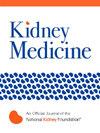优化剂量处方作为绿色连续肾替代治疗的第一步
IF 3.4
Q1 UROLOGY & NEPHROLOGY
引用次数: 0
摘要
目的:持续肾替代疗法(CKRT)需要大量的液体;然而,它经常在临床环境中被过度使用,导致液体浪费。本研究旨在探讨剂量优化对液体消耗和透析效果的影响。研究设计:单中心前瞻性研究。研究对象:所有于2023年5月1日至12月31日在釜山国立大学医院接受CKRT治疗的患者。根据肾脏疾病:改善全球结局建议,CKRT处方剂量从之前的35-25-30 mL/kg/h调整为靶向递送剂量在20 -25 mL/kg/h之间。主要终点是总液体消耗量的变化,次要终点是研究前后48小时CKRT后生化参数变化模式的差异(血清尿素氮、肌酐、钾、磷酸盐和碳酸氢盐)。分析方法:主要结局的一般线性模型;次要结果的重复测量方差分析。结果共纳入患者441例(N = 210),共纳入患者231例(N = 231)。中位年龄为70.0(61.0 ~ 77.5)岁;67.3%为男性,17.6%为终末期肾病。在研究之前,CKRT的处方中位数剂量为34.1 (33.0-35.4)mL/kg/h,液体消耗中位数为53.6 (43.0-63.2)L/人/d。在研究期间,中位给药剂量降至27.4 mL/kg/h (P < 0.001),总液体消耗量减少6.7 (3.7-9.8)L/人/d,塑料包装使用量中位数减少1.3 (0.8-1.9)(P < 0.001)。研究前后生化变化程度无显著差异。局限性:在患者较重的国家,节省液体的效果可能更大。结论:优化CKRT给药可以减少12.7%的液体消耗(即6.7 L/人/d),而治疗效果没有任何额外的变化。重症监护绿色化至关重要;然而,对于危重患者来说,这往往是具有挑战性的,因为绿化过程不应损害患者的安全。持续肾脏替代疗法是重症监护病房最常见的透析方法,需要大量的液体。本质量改善研究通过降低治疗强度来控制透析剂量,并分析其对液体节约和治疗效果的影响。在不影响透析效果的情况下,将剂量处方减少3.3 mL/kg/h,每人每天可节省约6.7 L液体和1.3包透析液。虽然这些只是患者个体水平上的微小变化,但如果在世界各地的中心采用类似的节省液体策略,它们对环境的影响将是巨大的。本文章由计算机程序翻译,如有差异,请以英文原文为准。
Optimizing a Dose Prescription as the First Step of Green Continuous Kidney Replacement Therapy
Rationale & Objective
Continuous kidney replacement therapy (CKRT) requires a large amount of fluid; however, it is often overused in clinical settings, leading to fluid waste. This study aimed to investigate the influence of dose optimization on fluid consumption and dialysis efficacy.
Study Design
Single-center prospective study.
Setting & Participants
All patients treated with CKRT at Pusan National University Hospital between May 1 and December 31, 2023.
Quality Improvement Activities
The CKRT prescription dose was adjusted from the previous 35-25-30 mL/kg/h, targeting delivered doses between 20 and 25 mL/kg/h, as per the Kidney Disease: Improving Global Outcomes recommendations.
Outcomes
The primary outcome was the change in total fluid consumption, and the secondary outcome was the differences in the pattern of biochemical parameter changes after 48 hours of CKRT before and after the study (serum urea nitrogen, creatinine, potassium, phosphate, and bicarbonate).
Analytic Approach
General linear model for the primary outcome; repeated measures analysis of variance for the secondary outcome.
Results
A total of 441 patients were included before (N = 210) and after (N = 231) participating in the study. The median age was 70.0 (61.0-77.5) years; 67.3% were male, and 17.6% had end-stage kidney disease. Before the study, the median prescribed dose for CKRT was 34.1 (33.0-35.4) mL/kg/h, with the median amount of fluid consumption being 53.6 (43.0-63.2) L/person/d. During the study periods, the median delivered dose was reduced to 27.4 mL/kg/h (P < 0.001), and total fluid consumption was reduced by 6.7 (3.7-9.8) L/person/d, with a median reduction in plastic package usage of 1.3 (0.8-1.9) (P < 0.001). The degree of biochemical changes was not significantly different before and after the study.
Limitations
The fluid-saving effect may be greater in countries with heavier patients.
Conclusions
Efforts to optimize CKRT dosing allowed for a 12.7% reduction in fluid consumption (ie, 6.7 L/person/d), without any additional changes in treatment efficacy.
Plain Language Summary
Greening of intensive care is essential; however, it is often challenging in critically ill patients, because the greening process should not compromise patient safety. Continuous kidney replacement therapy is the most common method of dialysis in the intensive care unit, requiring large amounts of fluid. This quality improvement study controlled the delivered dialysis dose by reducing treatment intensity and analyzed its impact on fluid savings and treatment efficacy. Reducing the dose prescription by 3.3 mL/kg/h resulted in savings of approximately 6.7 L of fluid and 1.3 dialysate packages per person per day, without compromising dialysis efficacy. Although these are small changes at the individual patient level, their impact on the environment would be substantial if similar fluid-saving strategies were adopted in centers worldwide.
求助全文
通过发布文献求助,成功后即可免费获取论文全文。
去求助

 求助内容:
求助内容: 应助结果提醒方式:
应助结果提醒方式:


